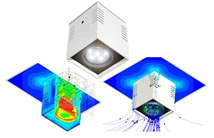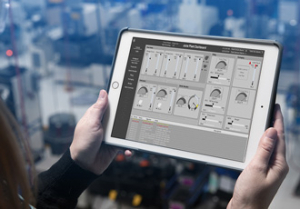Flow Simulation Helps Solve Power LED Overheating Problem in One Day
17th June 2008
Source:
Flomerics

Voxdale used Flomerics’ EFD.Pro computational fluid dynamics software to solve a power light emitting diode thermal management problem in just one day. The initial prototype of the LED system overheated to the point that the amount of light delivered by the device and its lifetime were both substantially reduced. Voxdale engineers used the CFD results to redesign the housing in just one day to improve airflow, which eliminated overheating and increased light output and life to the desired levels.
The recent innovation of high power LEDs has the potential to dramatically reduce the amount of power required for lighting residential and commercial buildings. Useful life for white LEDs can range from approximately 6,000 hours to more than 50,000 hours compared to less than 2,000 hours for incandescent bulbs. Thermal design typically represents the greatest challenge in LED system design projects because 75% to 85% of the energy used to drive LEDs is converted to heat and must be conducted from the LED die.
“The lighting systems manufacturer built a prototype of their design and discovered that the temperature of the LED quickly rose above its maximum operating temperature,” said Koen Beyers, President of Voxdale. “The manufacturer was anxious to get their product for market. Who knows how long it would have taken them to solve the problem by modifying and re-testing the prototype until they found a design that worked. The big problem with this approach is that you don’t have any idea what is causing the problem so you are essentially flailing around in the dark.”
“In the past, CFD required the user to have a deep understanding of the computational aspects of fluid dynamics in order to be certain of obtaining accurate results,” Beyers said. “But in the last few years a new generation of CFD software has been introduced that eliminates the need for engineers to master the computational part of CFD and instead allows them to focus on the fluid dynamics of the product. EFD.Pro, the CFD software that we use, uses native Pro/ENGINEER computer-aided design (CAD) data and automatically grids the flow space and manages flow parameters as object-based features.”
Beyers modeled the prototype using Pro/ENGINEER and entered the materials properties and boundary conditions required for CFD simulation. Defining all of the information needed to convert the CAD geometry to a CFD model took about 30 minutes. Then Beyers gave the command for the CFD software to mesh the fluid path around and through the housing. The simulation results showed the original designers had not provided enough outlets to enable the air to flow freely through the housing.
Beyers modified the design to increase the outlet area while keeping in mind that the manufacturers wanted to minimize their size for aesthetic reasons. His new design increased the flow through the housing while ensuring that air stayed in the housing long enough for considerable heat to be transferred to it. He also tried a few different variants of the heat sink to optimize their geometry in order to gain a bit more reduction in the size of the outlets. The new design met all of the client’s requirements.
“The lighting systems manufacturer built a prototype of their design and discovered that the temperature of the LED quickly rose above its maximum operating temperature,” said Koen Beyers, President of Voxdale. “The manufacturer was anxious to get their product for market. Who knows how long it would have taken them to solve the problem by modifying and re-testing the prototype until they found a design that worked. The big problem with this approach is that you don’t have any idea what is causing the problem so you are essentially flailing around in the dark.”
“In the past, CFD required the user to have a deep understanding of the computational aspects of fluid dynamics in order to be certain of obtaining accurate results,” Beyers said. “But in the last few years a new generation of CFD software has been introduced that eliminates the need for engineers to master the computational part of CFD and instead allows them to focus on the fluid dynamics of the product. EFD.Pro, the CFD software that we use, uses native Pro/ENGINEER computer-aided design (CAD) data and automatically grids the flow space and manages flow parameters as object-based features.”
Beyers modeled the prototype using Pro/ENGINEER and entered the materials properties and boundary conditions required for CFD simulation. Defining all of the information needed to convert the CAD geometry to a CFD model took about 30 minutes. Then Beyers gave the command for the CFD software to mesh the fluid path around and through the housing. The simulation results showed the original designers had not provided enough outlets to enable the air to flow freely through the housing.
Beyers modified the design to increase the outlet area while keeping in mind that the manufacturers wanted to minimize their size for aesthetic reasons. His new design increased the flow through the housing while ensuring that air stayed in the housing long enough for considerable heat to be transferred to it. He also tried a few different variants of the heat sink to optimize their geometry in order to gain a bit more reduction in the size of the outlets. The new design met all of the client’s requirements.
Similar articles
More from Flomerics
- Laser Design Offers SLP-500 High-Speed Laser Probe 14th May 2009
- Simulation Helps Develop Spray Gun with 50% Larger Pattern in Significantly Less Time 30th April 2009
- Giles Gaskell Joins Laser Design & GKS Inspection Services Team 17th March 2009
- Embedded CFD Helps Reduce Number of Thermal Prototypes from Up to 12 to 1 4th March 2009




 technology at Jacobs Vehicle Systems.JPG)







Write a comment
No comments